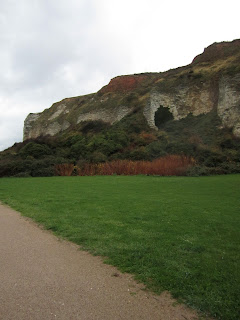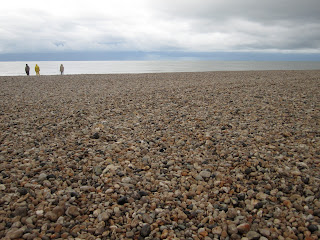BICYCLES!


And boy, are they everywhere! The only place I have seen with this many people commuting on two wheels was in Amsterdam. Apparently Stockholm won the 2010 greenest European capital award, and it's not difficult to see why. One of the more interesting and perhaps subtle manifestations of this "greenness" is the low concentration of privately-operated motor vehicles in the city. I'm not sure what prompted me to notice this except that I was out and about both at morning "rush hour" and the evening equivalent. There was little to no "traffic" to speak of. There are red buses, tramways, tunnelbana (subway), taxis, boats, bicycles, pedestrians and a steady flow of cars, but nothing that could come even close to being called "congestion". And those who do get behind the wheel of their own Volvo, Saab, Mercedes, BMW or Peugeot (the majority of the cars here) are quite friendly, often giving the right-of-way to the bí-ped or bi-wheel. Bicycles and pedestrians get their own lanes, and bikes even have their own traffic lights and street signs indicating the distances to various landmarks with in the city (in km, of course)!

Another example of Stockholm's commitment to Kermit's skin tone is the size of the parks and the number of gravel running paths. Browsing the free tourist map of Stockholm, one sees little icons of runners scattered through the typical map iconography. On my first morning, I took a jog down along the river. In addition to being numerous, the jogging paths are accessible to locals and tourists alike. Given the prevalence of signs both on the running path and around the streets, I managed an hour long run in a city where I had spent only about 3 waking hours, and I didn't make a single wrong turn. If you've kept up with my running adventures through the woods next to my apartment in Paris, you'll understand how vindicated I felt. The fact that the mental map I had made from looking at the physical map corresponded exactly to the actual layout of the city gave me a renewed confidence in my sense of direction. (And gives even greater support to the notion that the French are really trying to re-create Alice's Wonderland in the Bois de Vincennes.)
Having missed making the tournament in Stockholm by two places, the tennis and tourism gods have afforded me a little extra time to explore the capital of Scandinavia (according to the TI bureau).
 |
| Courts at Nasbypark Tennisklub (in Taby, north of the city) |
While I have certainly explored other areas of Stockholm including the old town on Gamla Stan, I have spent the most time on Djugarden.

As you'll notice in the photo of the map, most of the island is just that...a garden.



However, it also is home to some of Rick Steve's top rated sights to see in the city including Skansen, Nordika Museet (The Nordic Museum), and the Vasamuseet (home to a big 17th century ship). I've already visited two of the three and will probably check out the boat museum tomorrow. See Skansen and its playful Scandinavian animals (including reindeer!) below.


 |
| a Sami (formerly "Lapp") teepee |

 |
| Brown Bear, Brown Bear what do you see...? |
 |
| Elk |


 |
Reindeer (above) and Wolverines playing hide-and-seek
|
 |  |
Golden Pretzel marks the spot!
Vanilla creme-filled pastry - yummm! |
A trip to the Royal Palace is in the works as well. I had planned on doing the Smorgasbord and that Grand Hotel, but when I discovered online that the meal cost about 50 dollars (all-you-can eat, which never ends up being a good deal for the light to moderate eater) I opted for the budget version. What is the budget version you might inquire? Well, the following photograph will provide you with a small clue.

It consisted of a trip to the Coop Konsum (a grocery store) and about five to six hundred Krona that needed to be spent by the next day. While I only managed to spend about 312 SEK (definitely could have gone bigger, but I hadn't been keeping a close calculation of the cost of the items in my basket), I have a smorgasbord that will last months, and thus can be enjoyed in more manageable quantities. (You'll notice that most of the items are sweets.) Although I did manage to pick up some fish paste (salmon version), I didn't think that the meatballs would do too well in my suitcase.

Two traditional Swedish desserts are reserved for "fika" (a Swedish tradition that consists of coffee and a pastry - a modification of the word "kaffe", which just means "coffee"). Both of the desserts in question have and will come from a konditori (bakery) that I read about in the Scandiavian Air (SAS) in-flight magazine called Vete-Katten. The name refers to some sort of expression that uses "cats" (think "cat got your tongue"), but that actually has nothing to do with cats. (I can't remember what the expression was or what it refers to. I should be able to check on the airplane on the way back to France.) The first of the desserts, I enjoyed this afternoon in the kafferum (yep, coffee room). The "kanelbulle" (kah-nel-bu-lah), also known as a cinnamon roll, actually bears very little resemblance to its American cousin.
As one might expect in the comparison between American and European versions of a particular food, the American cinnamon roll is the kanelbulle on sugar steroids. The Swedish kannelbulle (at least the one at Vete-Katten), is actually a rather light sweet bread (not sweetbread), sprinkled with some course grains of sugar.
Even the cinnamon is not overpowering. Given that that KB lacks the gobs of butter and icing found smothering the American cinnamon roll, you can enjoy your treat without blowing your quota of calories for the week.

The second yummy dessert that I will check out tomorrow actually does bear resemblance to the American version that I have seen only one place in the US. The Princess Cake (the Swedish begins with something that looks like "princess" but ends with about 10 more letters tacked on) is a cream-filled sponge cake iced with marscapone cheese. While the one that is famous at the Albemarle Baking Company in Charlottesville, VA always has a neutral, ivory-colored marscapone, the two princesses that I have witnessed here in Stockholm are wearing a bright orange or bright green marscapone dress. Here they are filled with cream/custard and a bit of raspberry.
I guess it's a very good thing there are so many parks and opportunities for exercise in Stockholm. With all the options available for a daily gourmet fika, we might find more a few more obese Swedes waddling around.







































































